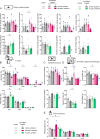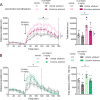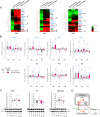Facilitating mGluR4 activity reverses the long-term deleterious consequences of chronic morphine exposure in male mice
- PMID: 33349673
- PMCID: PMC8136479
- DOI: 10.1038/s41386-020-00927-x
Facilitating mGluR4 activity reverses the long-term deleterious consequences of chronic morphine exposure in male mice
Abstract
Understanding the neurobiological underpinnings of abstinence from drugs of abuse is critical to allow better recovery and ensure relapse prevention in addicted subjects. By comparing the long-term transcriptional consequences of morphine and cocaine exposure, we identified the metabotropic glutamate receptor subtype 4 (mGluR4) as a promising pharmacological target in morphine abstinence. We evaluated the behavioral and molecular effects of facilitating mGluR4 activity in abstinent mice. Transcriptional regulation of marker genes of medium spiny neurons (MSNs) allowed best discriminating between 4-week morphine and cocaine abstinence in the nucleus accumbens (NAc). Among these markers, Grm4, encoding mGluR4, displayed down-regulated expression in the caudate putamen and NAc of morphine, but not cocaine, abstinent mice. Chronic administration of the mGluR4 positive allosteric modulator (PAM) VU0155041 (2.5 and 5 mg/kg) rescued social behavior, normalized stereotypies and anxiety and blunted locomotor sensitization in morphine abstinent mice. This treatment improved social preference but increased stereotypies in cocaine abstinent mice. Finally, the beneficial behavioral effects of VU0155041 treatment in morphine abstinent mice were correlated with restored expression of key MSN and neural activity marker genes in the NAc. This study reports that chronic administration of the mGluR4 PAM VU0155041 relieves long-term deleterious consequences of morphine exposure. It illustrates the neurobiological differences between opiate and psychostimulant abstinence and points to pharmacological repression of excessive activity of D2-MSNs in the NAc as a promising therapeutic lever in drug addiction.
Figures





Similar articles
-
VU0155041, a positive allosteric modulator of mGluR4, in the nucleus accumbens facilitates extinction and inhibits the reinstatement of morphine-induced conditioned place preference in male rats.Brain Res Bull. 2023 Jun 1;197:57-64. doi: 10.1016/j.brainresbull.2023.03.012. Epub 2023 Mar 30. Brain Res Bull. 2023. PMID: 36997034
-
The role of mGlu4 receptors within the nucleus accumbens in acquisition and expression of morphine-induced conditioned place preference in male rats.BMC Neurosci. 2021 Mar 21;22(1):17. doi: 10.1186/s12868-021-00627-2. BMC Neurosci. 2021. PMID: 33743609 Free PMC article.
-
Sex-Specific Role for Egr3 in Nucleus Accumbens D2-Medium Spiny Neurons Following Long-Term Abstinence From Cocaine Self-administration.Biol Psychiatry. 2020 Jun 1;87(11):992-1000. doi: 10.1016/j.biopsych.2019.10.019. Epub 2019 Nov 1. Biol Psychiatry. 2020. PMID: 31858986 Free PMC article.
-
Reflections on: "A general role for adaptations in G-Proteins and the cyclic AMP system in mediating the chronic actions of morphine and cocaine on neuronal function".Brain Res. 2016 Aug 15;1645:71-4. doi: 10.1016/j.brainres.2015.12.039. Epub 2015 Dec 29. Brain Res. 2016. PMID: 26740398 Free PMC article. Review.
-
Role of oxytocin in the neuroadaptation to drugs of abuse.Psychoneuroendocrinology. 1994;19(1):85-117. doi: 10.1016/0306-4530(94)90062-0. Psychoneuroendocrinology. 1994. PMID: 9210215 Review.
Cited by
-
VTA μ-opioidergic neurons facilitate low sociability in protracted opioid withdrawal.bioRxiv [Preprint]. 2024 Jul 11:2024.07.08.602522. doi: 10.1101/2024.07.08.602522. bioRxiv. 2024. Update in: J Neurosci. 2025 Apr 02;45(14):e1154242025. doi: 10.1523/JNEUROSCI.1154-24.2025. PMID: 39026700 Free PMC article. Updated. Preprint.
-
Advances in the characterization of negative affect caused by acute and protracted opioid withdrawal using animal models.Neuropharmacology. 2023 Jul 1;232:109524. doi: 10.1016/j.neuropharm.2023.109524. Epub 2023 Mar 30. Neuropharmacology. 2023. PMID: 37003572 Free PMC article. Review.
-
[High expression of ELFN1 is a prognostic biomarker and promotes proliferation and metastasis of colorectal cancer cells].Nan Fang Yi Ke Da Xue Xue Bao. 2025 Jul 20;45(7):1543-1553. doi: 10.12122/j.issn.1673-4254.2025.07.22. Nan Fang Yi Ke Da Xue Xue Bao. 2025. PMID: 40673318 Free PMC article. Chinese.
-
Chronic sodium bromide treatment relieves autistic-like behavioral deficits in three mouse models of autism.Neuropsychopharmacology. 2022 Aug;47(9):1680-1692. doi: 10.1038/s41386-022-01317-1. Epub 2022 Apr 13. Neuropsychopharmacology. 2022. PMID: 35418620 Free PMC article.
-
Opioidergic tuning of social attachment: reciprocal relationship between social deprivation and opioid abuse.Front Neuroanat. 2025 Jan 23;18:1521016. doi: 10.3389/fnana.2024.1521016. eCollection 2024. Front Neuroanat. 2025. PMID: 39917739 Free PMC article. Review.
References
-
- APA. Diagnostic and statistical manual of mental disorders: DSM-5. Washington, DC: American Psychiatric Association; 2013.
-
- Goodwin RD, Stayner DA, Chinman MJ, Wu P, Tebes JK, Davidson L. The relationship between anxiety and substance use disorders among individuals with severe affective disorders. Compr Psychiatry. 2002;43:245–52.. - PubMed
-
- O’Brien CP. Anticraving medications for relapse prevention: a possible new class of psychoactive medications. Am J Psychiatry. 2005;162:1423–31.. - PubMed
Publication types
MeSH terms
Substances
LinkOut - more resources
Full Text Sources
Other Literature Sources
Research Materials
Miscellaneous

